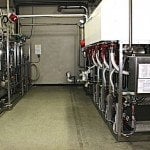No doubt it is mere coincidence that the day after the giant Trans-Pacific Partnership (TPP) deal was signed in Atlanta, a far-reaching trade deal that many fear will further gut Canada’s auto sector, Statistics Canada released its August export numbers. Exports declined by 3.6 per cent, with the result that the country’s trade deficit with the rest of the world grew from $817 million in July to $2.5 billion in August. Amid the widespread decline in Canada’s exports, particularly sharp in energy products, one sector did perform well: autos. Exports of cars and parts rose 3.1 per cent, to $7.8 billion, almost entirely, says Statistics Canada, in the form of passenger cars and light trucks, which were up 4.5 per cent.
The drop in energy prices and consequent reduction in investment in the energy sector have now prompted the International Monetary Fund (IMF) to cut its projection for Canada’s economic growth to just 1 per cent for 2015. It had projected growth of 2.1 per cent last April. Commodity exporters are particularly vulnerable to lower commodity prices, as disposable income is reduced and investment dries up.
Oil prices, however, may be expected to rebound at some point, and investment money will start to flow again. The hostile takeover bid for Canadian Oil Sands by Suncor Energy at a time when world oil prices are depressed is seen as a vote of confidence in the sector: Suncor stands to buy the assets at bargain prices, and see them rise again. When they do, investment will resume and jobs will return to the oil fields.
What worries some auto sector observers about the TPP deal, however, is that manufacturing jobs will be lost never to return. Under the terms of the North American Free Trade Agreement (NAFTA), vehicles built in any of the three North American countries must have local content of 62.5 per cent. Just over half of a vehicle and its parts must be manufactured locally. Under TPP, that local content requirement drops to 45 per cent. This means that cars manufactured outside of Canada would be allowed into the country without tariffs as long as they have 45 per cent TPP content. Japan reportedly wanted even less, just 40 per cent, but was out negotiated.
A spokesman for the Economic Strategy Institute, a research group based in Washington, DC, said that the auto terms in TPP would have a “negative impact” on the US auto industry and “probably” also on the Canadian and Mexican industries as well. This is certainly the position taken by Jerry Dias, president of Unifor, who has said the agreement poses a “major threat” to the auto industry in Canada. Dias says the union has calculated that 20,000 jobs in Canada are put at risk by the agreement, though he has not revealed precisely what that number is based on.
The fact that the Canadian government has promised (in the midst of an election campaign) to make $1 billion in “incentive” money available to the auto sector shows that it is aware of the potential negative impacts facing the industry from TPP. However, at least one industry group, the Automotive Parts Manufacturers Association, said in a statement that the terms of the TPP would have varying effects on the parts makers. Large multinational Canadian suppliers like Magna International will have greater access to foreign markets, while smaller suppliers will face new competitive pressures. Its members, 81,000 strong, are evenly split on the benefits/drawbacks of the deal. Until it is ratified and implemented, it is impossible to be sure what the impact will be.


































